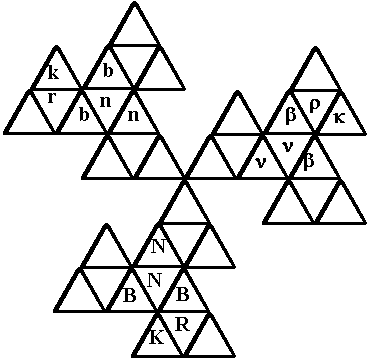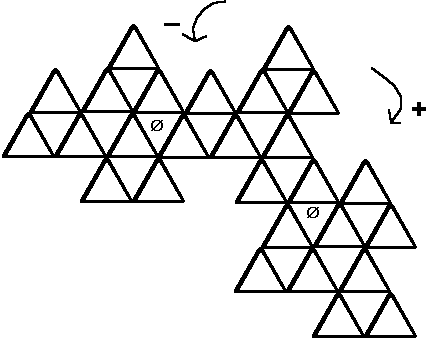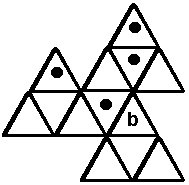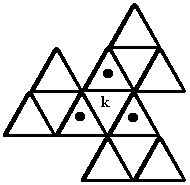Pirate Chess
We received the following email from Guillermo Alcántara in late October 1998:
Hi, My name is Guillermo Alcántara from Mexico and would like to participate in your contest. I hope you enjoy the game and as I enjoyed trying to figure out how to put 39 cells to make a chess variant.
Sincerely a player who loves chess and anything related to it.
Guillermo
Introduction
While thinking about the 39-contest, I found it to be very difficult to make a symmetric board with just 39 cells. I am the kind of chess player who loves the symmetry of the game. Finally, I have an idea from the top of my head, why not change it to triangles. After all, 39 is divisible into 3 and 13. Then I thought about a 3D chess, but it would be too complicated and too small to be really playable and enjoyable. While dreaming on the bus I got the idea of ships and chess, so we have "Pirate Chess". I don't know of any game similar to this one.
Editor's note: There was a submission for the 38 square contest that was also built on a pirate theme called Pirates-Henge-Ho, although it bears no resemblance to this game.
If I had an influence, sorry but I don't remember (well, maybe the Star Trek 3D chess for the movement of the ships). Remember this game is for two or three players.
Objective
To check the king of the other players.
Notation

As usual, uppercase for white party (W), lowercase for black party (B), and in this case for the gray party (G) Greek lowercase. So each army has 6 pieces: 2 knights (N, n, n), 2 bishops (B, b, b), 1 rook (R, r, r), 1 king (K, k, k).
[Editor's note: some systems may not display the greek characters correctly:
n is the greek letter nu,
b is the greek letter beta,
r is the greek letter rho,
k is the greek letter kappa]
Normal Parameters
(board)piece(position/movement)

Since the initial configuration is radially symmetrical, it follows that for every army the start up configuration is:
(W)K5a (B)k5a
B4b,6b b4b,6b
N5b,5c ...
(See below to see why I decide to start with 2 in the x-axis).
Extra Parameters
When sliding the ship:
(Board that moves) ± (Static Board)
If it slides clockwise it is +, otherwise - (counterclockwise). It is optional to write the third board in case the final position is a 3-point intersection as in the initial setup.
When spinning the ship:
(Board)C if the spin is clockwise or (Board)CC if the spin is counterclockwise
It is optional to write the vertex center of the rotation. It would be necessary in case a ship is touching two points of another ship. To see how to locate a point see below.
To locate a ship:
(Board to locate) "additional cell" (Board of reference)
Since boards act in the game it is important to have a control of how is the board not only of where are the pieces. Here it is the initial configuration for the ships:
(B)5e(W) and (G)7e(W)
(Note that the position from the other points of view is the same but swapped)
(G)5e(B) and (W)7e(B)
Now you see why to start in 2a instead of 1a. It is recommendable to use a ship that is touching the other ships. In case you want examples of the things above. The phi (j) represents a hole.


The images are self-explicit, the ships can surround each other making more points in common. The right image explains how it is necessary to have only two ships in a point to spin. You would see that it is necessary for the development of the rook. After the spin, they can be adjacent ships and can move as usual.
Movement
All pieces move and capture in the same way and don't jump through holes.
Knight: It moves to a vertex of its triangle and then to another triangle that is not adjacent or opposite by the vertex.


Bishop: It moves adjacent or opposite by the vertex as long as it can.
Rook: It moves through the rows in any angle.


King: It moves adjacent.
Note that the knight and bishop can pass through the vertices while the rook cannot. Also that the bishops can help each other. A spin is necessary to make possible the rook attack. The R is the most powerful piece, so I only put one. Two kings can be together by the opposite vertex. I maintained the density of the board vs pieces. I think the images are self-explicit.
To move a ship you need to have your king on the ship and that the slide doesn't push another ship or that they don't overlap. A movement is between two ships so you can actually move another ship if it is only touching your ship and you make a move. To move a ship is considered to take a turn, so you either move a piece or your ship. A ship without its king would never again move, so moving your king to another ship will not give you control even if it is empty. (Some variants can be to be able of push ships or to gain power to move ships.)
To spin a ship you also need its king, that the spin doesn't overlap the ships, and that the angles between them are multiples of 60° (We don't want ships with 45° or so degrees). As a result, A ship can only spin if it is not in 3-point intersection, so at the start no one can spin.
Comments
Please take notice that English is not my first language, so if you have questions, ideas or anything email me at (email removed contact us for address) ketmail.com.
Also see that the 39 cells were an obstacle for including a more "Pirate" theme in the game. After playing with some friends I find it very enjoyable and dynamic.
This is a submission for the contest to design a chess variant on a board with 39 squares.
Text and diagrams by Guillermo Alcántara. HTML conversion and slight editing by David Howe.
WWW page created: November 1, 1998.